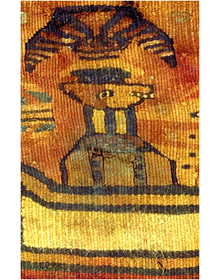resources
Museum Collections - Ancient Peru - Lambayeque

The descendants of the Moche established a new centre of the Lambayeque culture around A.D. 800. It was located at Batan Grande in the La Leche Valley on the north coast of Peru. Between A.D. 900-1100 it grew to become the region's political and religious centre. The population of Batan Grande included many skilled metal workers. The tombs of Batan Grande lords have held gold and silver keros (beakers), emeralds, pearls and mummy bundles with gold funerary masks with semi-precious stones, shell and feathers. Other works in clay, wood inlaid with shell, and textiles depict sea birds, fish and scenes of Spondylus shell diving. These shells were collected further north in Ecuador. When the Spanish arrived in the area, they documented that a top-level official was responsible for laying a red carpet of ground Spondylus shell powder before the ruler as he walked. Textiles from the Lambayeque valley show a combination of Moche, Wari and local elements such as characteristic eyes and crescent headdresses, sea motifs and slit tapestry. Around A.D. 1100, the site was abandoned and burned, and a new centre was established at Túcume (which was eventually conquered by the Chimú in A.D. 1350).



